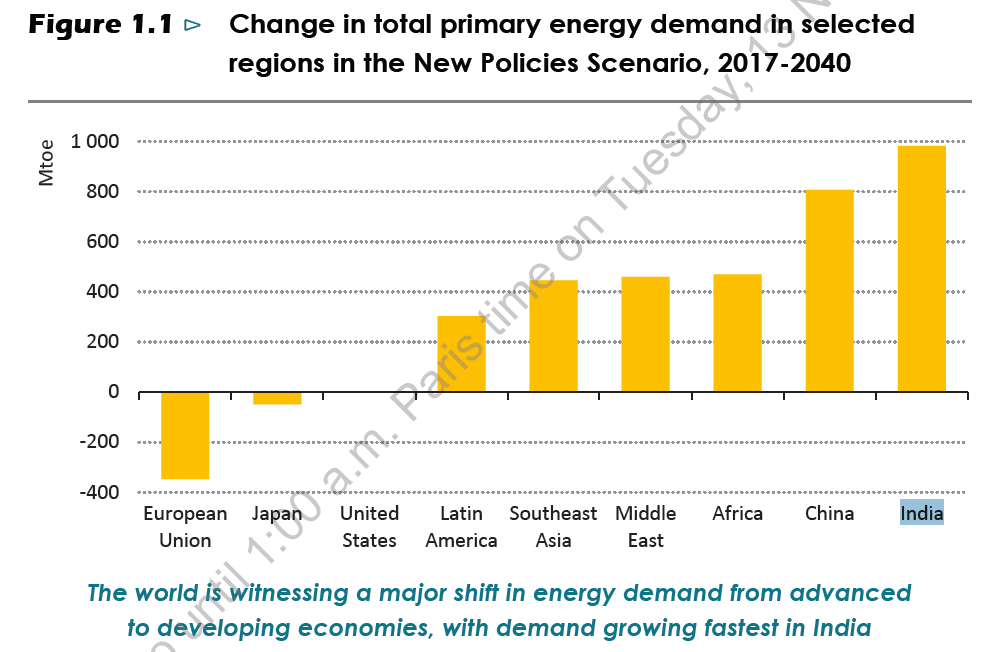If countries go as per their planned policies, the IEA’s New Policy Scenario predicts that global primary energy demand will grow by over 25%, from 14 giga tonnes of oil equivalent (Gtoe) in 2017 to 18 Gtoe in 2040. Without improvements in energy efficiency, the rise could be twice as large, says the latest report by IEA, which projects how policy choices could lead the global energy sector.
India will be the largest single source of growth and its energy demand will more than double from 898 million tonnes of oil equivalent (Mtoe) in 2017 to 1880 Mtoe in 2040. China (at 3858 Mtoe in 2040) would cement its position as the world’s largest energy consumer, meanwhile.
Thus, by 2040, energy demand in India could reach around half that of China, up from less than 30% today.
However, if the policies are aligned with sustainable development goals, global energy demand could stay flat at 14 Gtoe out to 2040 – reflecting the continuing potential of energy efficiency to reduce demand. Coal would move to the back of the pack, with demand of 1,600 Mtoe in 2040 in line with 1975 levels, when the global economy was barely a quarter the size of today.
Overall, China’s demand will decline, while India’s energy use will continue to grow through to 2040.
Renewable growth
With policies aligned with sustainable development goals, India’s renewable energy consumption could grow almost five times from 57 Mtoe in 2017 to touch 277 Mtoe by 2040 (as against 200 Mtoe achieved with planned policies).
Globally, additional measures to incentivise investment in renewables based electricity, biofuels, solar heat, geothermal heat and electrification could push the share of renewables in total global electricity generation from 25% in 2017 to 66% in 2040 (as against around 40% achieved with planned policies).
As sustainable development scenario includes additional policy measures to support increased deployment of renewable-based electricity across all regions, cumulative investment in renewables-based power generation could be US$12.8 trillion over the outlook period (2017-2040), with wind accounting for 34%, followed by solar PV (33%) and hydropower (18%).
In the absence of such measures, cumulative global spend on renewables investment will be $8 trillion over the outlook period, with wind power and solar PV accounting for two-thirds. Hydropower will account for 20% of the remaining renewables-based power investment, with bioenergy and concentrating solar power making up the balance. China, the European Union, the United States and India will account for more than 60% of the total investment in renewable power generation, reports the IEA.
Flexibility is the new watchword
The increasing competitiveness of solar PV will push its installed capacity beyond that of wind before 2025, past hydropower around 2030 and past coal before 2040. The majority of this will be utility-scale, says the agency, although investment in distributed solar PV by households and businesses will play a strong supporting role.
In its New Policies Scenario, renewables and coal switch places in the power mix: the share of generation from renewables would rise from 25% today to around 40% in 2040, while coal would tread the opposite path.
As the share of wind and solar PV grows, so does the need for flexibility to ensure reliable power supply. The rise of solar PV and wind power would give unprecedented importance to the flexible operation of power systems in order to keep the lights on.
There are few issues at low levels of deployment, but in the New Policies Scenario many countries in Europe, as well as Mexico, India and China, would require a degree of flexibility that has never been seen before at such large scale. The cost of battery storage would decline fast, and batteries would increasingly compete with gas-fired peaking plants to manage short-run fluctuations in supply and demand.
Excellent electrification
The IEA report found that for the first time in 2017, the number of people without access to electricity fell below one billion. India has been billed as a star performer, after the government announced in April that all villages in the country had an electricity connection.
Read further coverage on the 661 page report on pv magazine Global – Solar PV capacity to overtake all but gas by 2040 – and pv magazine Australia – IEA highlights the viability of Australian ‘green hydrogen’. More coverage on our German, LatAm and US sites will follow.
This content is protected by copyright and may not be reused. If you want to cooperate with us and would like to reuse some of our content, please contact: editors@pv-magazine.com.









1 comment
By submitting this form you agree to pv magazine using your data for the purposes of publishing your comment.
Your personal data will only be disclosed or otherwise transmitted to third parties for the purposes of spam filtering or if this is necessary for technical maintenance of the website. Any other transfer to third parties will not take place unless this is justified on the basis of applicable data protection regulations or if pv magazine is legally obliged to do so.
You may revoke this consent at any time with effect for the future, in which case your personal data will be deleted immediately. Otherwise, your data will be deleted if pv magazine has processed your request or the purpose of data storage is fulfilled.
Further information on data privacy can be found in our Data Protection Policy.